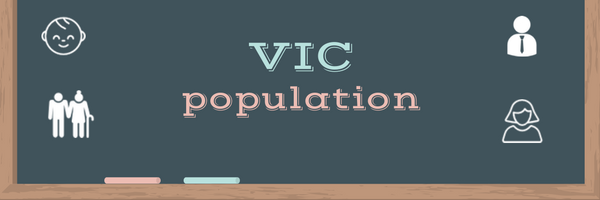
Victoria also known as VIC is the second most populated state in Australia. The state’s capital city is Melbourne. Melbourne has an estimated population of over 6 million people. Aboriginal and Torres Strait Islanders account for 0.7 percent of the Victorian population. Victoria has a total area of 227,416 km2 which accounts for 3 percent of Australia’s total land mass, and makes it the smallest mainland state. Victoria’s coastline is 1800 km long and borders Bass Strait, the body of water that separates the mainland from Tasmania.
Based on our research Victoria population will reach 6.929 million by the end of June of 2024. We use end of June each year due to Australia Bureau of Statistics always follow Australia financial year when pushed the data. The calculation is based on the average growth rate of 1.75% over last 12 years since 2011. We believe using the recent years’ figures (see the table in next section) will make the estimation more accurate.
Population Growth of Victoria
Looking back last twelve years of Victoria’s population, the growth rate is very consistent ranging from 0.35% to 2.55%, adding around 20,000 to 150,000 people each year to the overall population. Lot of workers was moving to Victoria to take advantage of employment opportunities there, which contributes to the population growth. Of all the states, Victoria’s population growth is above national average.
| Year | Population | Growth rate |
| 2011 | 5.53 million | n/a |
| 2012 | 5.60 million | 1.27% |
| 2013 | 5.74 million | 2.50% |
| 2014 | 5.76 million | 0.35% |
| 2015 | 5.88 million | 2.08% |
| 2016 | 6.03 million | 2.55% |
| 2017 | 6.15 million | 1.99% |
| 2018 | 6.27 million | 1.95% |
| 2019 | 6.35 million | 1.28% |
| 2020 | 6.50 million | 2.36% |
| 2021 | 6.62 million | 1.85% |
| 2022 | 6.71 million | 1.36% |
| 2023 | 6.81 million | 1.49% |
Demography of Victoria
According to 2011 Australia census, 49.2 percent of Victorians are male and 50.8 percent are female. The top five ancestries for people in Victoria are: English, Australian, Irish, Scottish and Italian. The top five languages (other than English) spoken in Victoria are: Italian, Greek, Mandarin, Vietnamese and Cantonese. The top six countries of birth for people in Victoria are: Australia, England, India, China, New Zealand, and Italy.
The religious makeup of Victoria is: 26.7% Catholic, 24.0% No religion, 12.3% Anglican, 8.3% Religious affiliation not stated, 4.7% Uniting Church, 4.3% Eastern Orthodox, 3.1% Buddhism, 2.9% Islam, 2.7% Presbyterian and Reformed, 1.9% Christian.
In Victoria, 49.1% of people are married, 34.7% have never married and 7.8% are divorced and 2.9% are separated. There are 242621 widowed people living in Victoria.
Population Density of Victoria
Victoria’s population density is 23.54 people per kilometer, which is ranking 2nd most populated state in Australia after Australian Capital Territory. It is surprised to see ACT has topped VIC in the population density consider the size of its population.
| Position | State | Population density |
| 1 | Australian Capital Territory | 151.49 |
| 2 | Victoria | 23.54 |
| 3 | New South Wales | 8.64 |
| 4 | Tasmania | 7.24 |
| 5 | Queensland | 2.50 |
| 6 | South Australia | 1.62 |
| 7 | Western Australia | 0.89 |
| 8 | Northern Territory | 0.16 |
Occupations and Industries
The main occupations of people living in Victoria are: 22.3% Professionals, 14.4% Clerical & administrative workers, 13.9% Technicians & trades workers, 13.2% Managers, 9.7% Sales workers, 9.3% Community & personal service workers, 9.0% Labourers, 6.1% Machinery operators & drivers, 2.2% Occupation inadequately described/ Not stated.
The main industries people from Victoria work in are 11.6% Health care and social assistance, 10.8% Retail trade, 10.7% Manufacturing, 8.3% Construction, 8.0% Education and training, 7.8% Professional, scientific and technical services, 6.1% Accommodation and food services, 5.3% Public administration and safety, 4.7% Transport, postal and warehousing.
Facts About Victoria
- Victoria is often referred to as the ‘Garden State’.
- Victorian scientist Dr David Warren was the first person to think of and develop the Black Box flight recorder.
- Over 180 languages and dialects are spoken in Victoria. More than 20 percent of Victorians – and almost 30 percent of Melburnians – speak a language other than English at home.
- The iconic ute (utility vehicle or coupe utility) was first made by Ford Australia at their Geelong plant in Victoria in 1934.
- More than 70 percent of Victorians live in Melbourne, the state’s capital city.
- Victoria is the smallest mainland state – about the same size as Britain.
- Victoria’s food processing sector contributes about 26% of the total manufacturing exports of the state.
- Melbourne has the highest number of restaurants and cafes per number of people than any other city in the world!
References
The following links provides data for this topic:
- Australian Bureau of Statistics: www.abs.gov.au
- Melbourne, Australia: www.visitmelbourne.com
- Victorian Government: www.vic.gov.au
